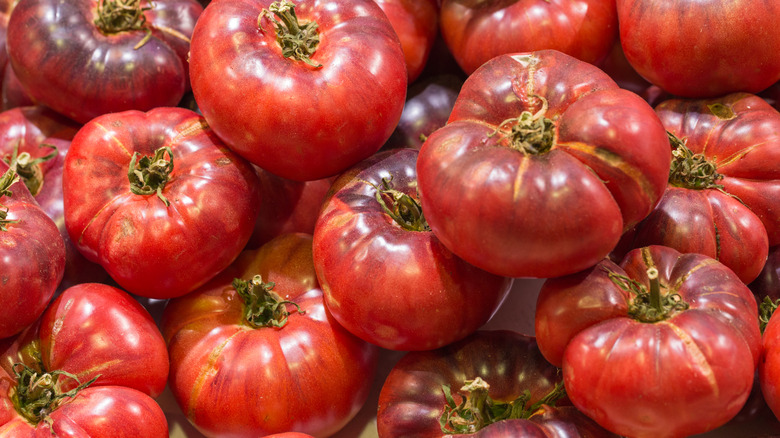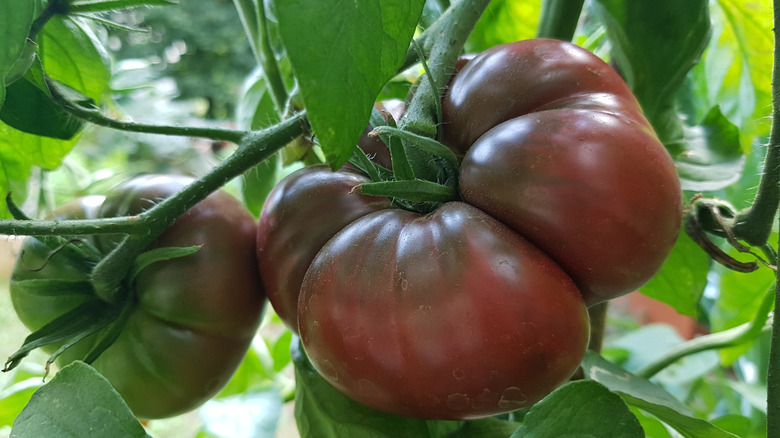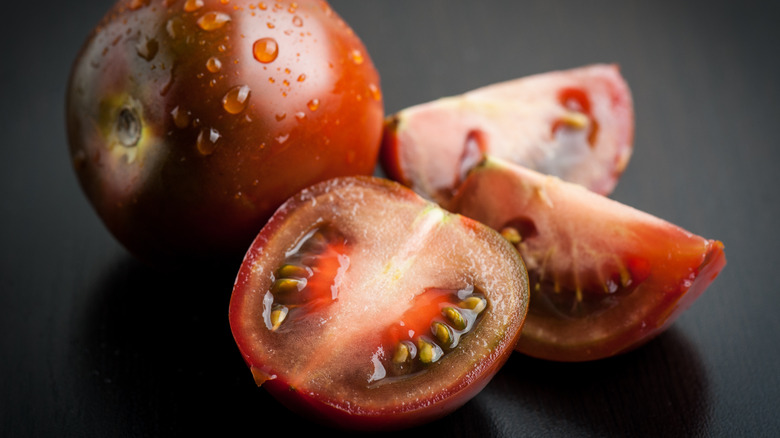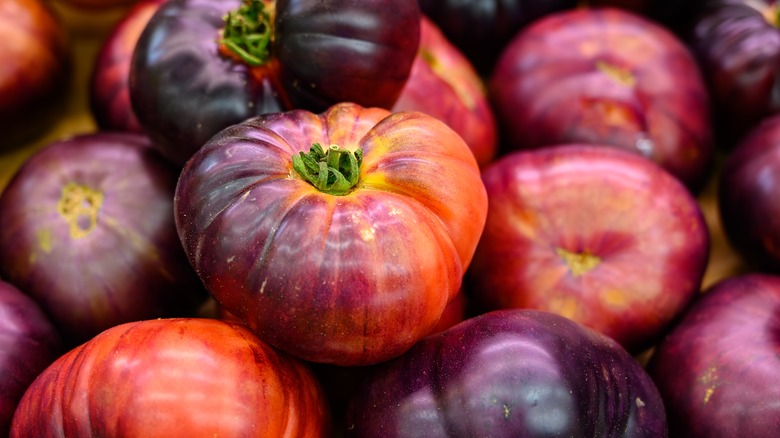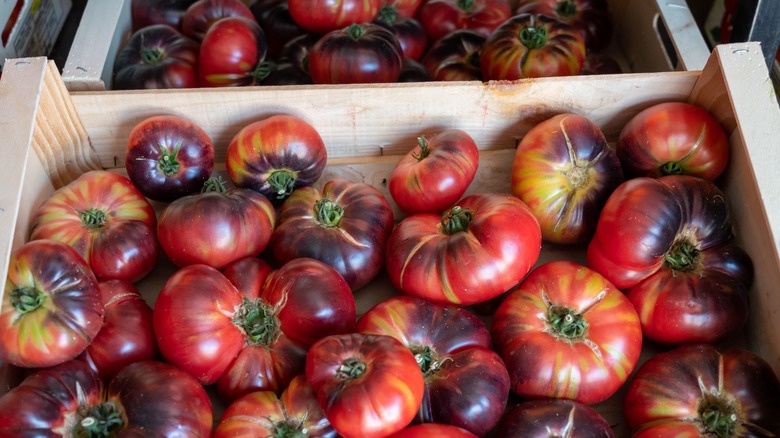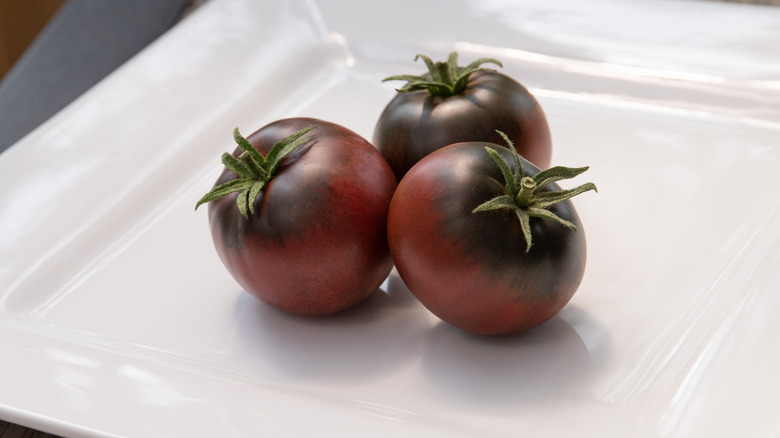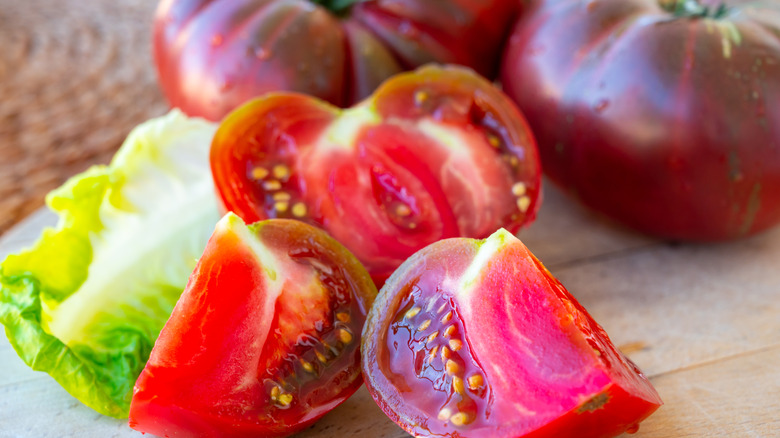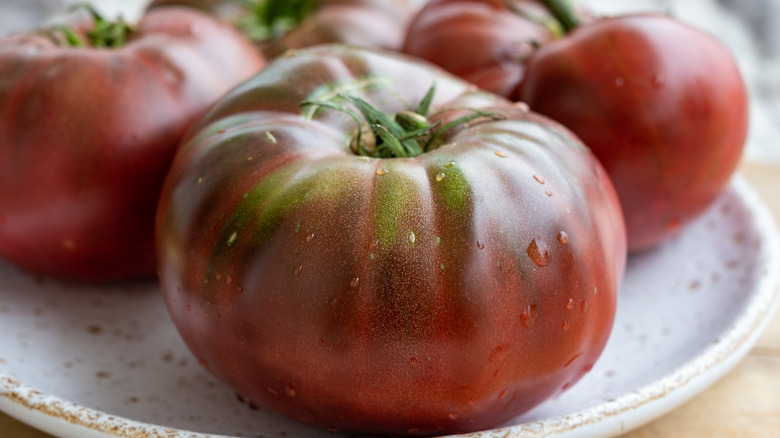Black Krim Tomatoes Are A Sweet Variety That Originated In Crimea
Tomatoes are one of the world's most versatile fruits — and arguably one of the most popular fruits, as well. Although they originated in Central and South America, nowadays, they pop up in nearly every cuisine across the world. This means that over time, thousands of varieties have been cultivated and adapted to different regions and purposes. One of these varieties, the Black Krim tomato, has become particularly popular on the West Coast and among chefs due to its especially flavorful yet balanced taste.
Black Krim tomatoes (Solanum lycopersicum) are originally from Crimea, which is on the northern coast of the Black Sea. While these tomatoes were only introduced to the United States in 1990, they are actually one of the oldest kinds of black tomatoes, which are the most nutritious variety of tomatoes. Black Krims are believed to be the first black tomatoes to be circulated in the United States, but since then, they have established a reputation as one of the world's best-tasting tomato varieties.
What are Black Krim tomatoes?
With its green shoulders and reddish-black flesh that darkens even more in the heat, Black Krim tomatoes are named both after their dark color, as well as their origins in Crimea ("Krym" means "Crimea" in Slavic languages). In case you don't know your tomatoes, considering they are both an heirloom tomato and a beefsteak, Black Krims are optimal for roasting and baking and enjoying fresh. As an heirloom tomato, Black Krims have been open-pollinated, which means that the seeds that are produced are a nearly exact genetic match. Additionally, to be categorized as a traditional heirloom, the tomato must have been a variety for 25 to 50 years or so, with the seeds being passed down from generation to generation, hence the name, "heirloom."
Exactly how long Black Krim tomatoes have existed is unclear, and accounts differ. However, they spread throughout Europe after their seeds were collected by British, French, Italian, and Turkish soldiers during the Crimean War in the 1850s. They didn't reach wider circulation until the 1990s after Lars Olov Rosenstrom of Sweden introduced them to the Seed Savers Exchange.
How are Black Krim tomatoes grown?
These low-maintenance tomatoes are a favorite among home gardeners for several reasons. First of all, these tomatoes don't require much. For these plants to thrive, mainly, they need a ton of light (six to eight hours), and moderate amounts of water (cracking will occur without enough water), but once they are established, they can tolerate drought to a certain extent. Thanks to their Crimean origins, these tomatoes thrive in temperate to warmer climates — for outdoor growing, they just require a minimum temperature of 50 degrees Fahrenheit and a minimum soil temperature of 60 degrees Fahrenheit.
After planting, it usually takes 70 to 90 days to mature, but once they do, Black Krims typically produce large, somewhat flattened, globe-shaped fruit (think around 6 inches or so) that generally weigh between 10 to 16 ounces each. However, they have been known to occasionally weigh more than a pound. These plants are considered fairly robust, and high-yield, making them a worthwhile endeavor if you're looking to add an easy-to-care-for fruit or vegetable to your garden.
What do Black Krim tomatoes taste like?
You may notice that these flavorful heirlooms have been popping up across gourmet and farm-to-table restaurant menus across the country, and there's a good reason for that. Black Krim tomatoes have a more intense flavor than your classic tomato, but are also less acidic, making them a favorite of some chefs. Often described as tangy, rich, and sweet, Black Krims have a balanced flavor profile, which makes them ideal for nearly any recipe that calls for tomatoes.
Black tomatoes in general tend to have a more complex flavor than your generic tomato variety, and Black Krims are no exception. Black Krims have a smooth and meaty texture, and some consider Black Krims to taste slightly earthy. You may even detect a slight saltiness or smokiness, but this can depend on environmental factors during the growing process. If you're growing your own, keep in mind that Black Krims will taste even better the longer they stay on the vine.
How to cook with Black Krim tomatoes
These maroon tomatoes are typically served raw due to their strong flavor and aromatic quality. Try adding them to your sandwiches or salads for both a nutritious and fresh lift, but note that Black Krim tomatoes pack a flavorful punch and can stand on their own — just a pinch of salt is enough to boost the flavor of fresh Black Krim tomatoes and amplify their salty quality without becoming overpowering. If you want to keep things simple but a bit more elevated, layer sliced Black Krims over bread and top with olive oil, basil, and salt.
While eating them raw is the best way to appreciate all the flavorful nuances that Black Krims have to offer, don't feel limited to enjoying this variety fresh. Black Krim tomatoes are highly adaptable for many recipes and uses and can be used as a darker, slightly sweeter alternative in soups or sauces. They are also delicious when roasted, and their moderately salty flavor also makes them ideal for juices or cocktails like this tried-and-true Bloody Mary recipe at your next brunch.
Where to buy Black Krim tomatoes
Black Krim tomatoes can typically be found at natural and organic groceries, such as Whole Foods Market or Sprouts Farmers Market in the late summer to early fall, or at your local farmers market. When selecting your tomatoes, make sure to give them a smell at their stem — they should be fragrant and sweet. Check for any dark spots or dried stems indicating they're past their peak and are beginning the rotting process. Also, try gently pressing the tomato's outside to test its firmness. You'll want a tomato that isn't soft all over but also isn't too hard.
If you're open to growing your own, seeds can be purchased at several online sellers. Seeds can be purchased from Seed Savers Exchange for $3.95 to $17.06 depending on the amount of seeds, or from Johnny's Selected Seeds, starting at $4.95 for a packet, but they are readily available at many other online seed distributors.
Black Krim tomatoes vs. Cherokee Purple
Black Krims are most often compared to the Cherokee Purple variety — both are darker-colored slicer tomatoes (meaning they don't have to be cooked), ideal for sandwiches, and are indeterminate, meaning they will keep on growing all season until they are killed by frost. If you're not paying close attention, these two could be used interchangeably, as they both are consistently ranked highly for their rich tastes. However, Cherokee Purple tomatoes tend to be more acidic and tart in flavor and are not as balanced as Black Krim tomatoes. If you end up cooking with Cherokee Purple tomatoes, you'll want to add a bit of sugar to neutralize the taste — a step you can skip with Black Krims.
If you're debating between the two to grow yourself, Cherokee Purple tomatoes, which were first cultivated by the Cherokee tribe, tend to grow larger. For this reason, they can take a bit longer to fully mature. But apart from that, both require fairly similar growing processes, and both are considered relatively disease and pest-resistant.
Nutritional information about Black Krim tomatoes
Like other tomato varieties, Black Krim tomatoes are nutritional powerhouses. Considered a superfood, tomatoes are packed with high levels of fiber, vitamin A, and vitamin C. Additionally, Black Krims are rich in antioxidants due to lycopene and anthocyanin, which cause its dark coloring. Regular consumption of black tomatoes and other anthocyanin-rich foods has been linked to protection against coronary heart disease.
But that barely scratches the surface when it comes to tomatoes' nutritional benefits — tomatoes can also support eye health, thanks to their lycopene, lutein, and beta-carotene content, which can protect the eyes from light-induced damage, and the development of cataracts. Tomatoes can even benefit your skin and provide support during pregnancy. Unsurprisingly, Black Krims have a high water content, which means you get an extra hydration boost, as well. If you want to maximize your nutritional benefits, some research indicates that cooking your tomatoes is your best bet, as it increases their nutritional content.
How to store Black Krim tomatoes
Like most tomatoes, it is best to keep your Black Krim tomatoes at room temperature before they are ripe, as storing them in the refrigerator will negatively impact the flavor and texture. Black Krims are tomatoes you won't want to waste, so if you don't think you'll be able to eat them in time, try freezing your tomatoes.
To do so, you'll want to slice them first, as tomatoes won't retain their shape while frozen, and they may crack while defrosting if they are frozen whole. Simply throw them into an airtight container, or freeze them on a cookie sheet for two hours before putting them into freezer bags. Frozen tomatoes will retain their flavor for up to a year, although their quality will start to diminish after about six months. It's also important to note that they will no longer be solid once thawed, which means they will be optimal for cooking.

